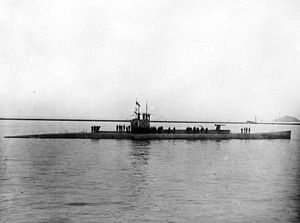HMS J7
 HMAS J7
| |
| History | |
|---|---|
| Name | HMS J7 |
| Builder | HM Dockyard, Devonport |
| Launched | 12 February 1917 |
| Fate | Transferred to Australia, 25 March 1919 |
| History | |
| Name | HMAS J7 |
| Acquired | 25 March 1919 |
| Decommissioned | 12 July 1922 |
| Fate | Sunk 4 June 1926 |
| General characteristics | |
| Class and type | British J class submarine |
| Displacement |
|
| Length | 275 ft (84 m) |
| Beam | 22 ft (6.7 m) |
| Draught | 14 ft (4.3 m) |
| Propulsion |
|
| Speed |
|
| Range | 4,000 nmi (7,400 km; 4,600 mi) at 12 kn (22 km/h; 14 mph) |
| Test depth | 300 ft (91 m) max[citation needed] |
| Complement | 44 personnel |
| Armament |
|
HMS J7 (later HMAS J7) was a J-class submarine operated by the Royal Navy and the Royal Australian Navy.
Design and construction
The J class was designed by the Royal Navy in response to reported German submarines with surface speeds over 18 knots (33 km/h; 21 mph).[1] The submarines had a displacement of 1,210 tons surfaced, but J7 had a lighter submerged displacement than her sister boats, at 1,760 tons.[1] Each submarine was 275 feet (84 m) in length overall, with a beam of 22 feet (6.7 m), and a draught of 14 feet (4.3 m).[1] The propulsion system was built around three propeller shafts; the J-class were the only triple-screwed submarines ever built by the British.[1] Propulsion came from three 12-cylinder diesel motors when on the surface, and electric motors when submerged.[1] Top speed was 19 knots (35 km/h; 22 mph) on the surface (the fastest submarines in the world at the time of construction), and 9.5 knots (17.6 km/h; 10.9 mph) underwater.[1] Range was 4,000 nautical miles (7,400 km; 4,600 mi) at 12 knots (22 km/h; 14 mph).[1]
Armament consisted of six 18 inch (450 mm) torpedo tubes (four forward, one on each beam), plus a 4-inch deck gun.[1] Originally, the gun was mounted on a breastwork fitted forward of the conning tower, but the breastwork was later extended to the bow and merged into the hull for streamlining, and the gun was relocated to a platform fitted to the front of the conning tower.[1] The conning tower on J7 was sited 60 feet (18 m) further back than her sister boats, as the control room was located behind the machinery spaces.[1][2] 44 personnel were aboard.[1]
J7 was built by HM Dockyard Devonport in Plymouth and launched on 12 February 1917.[3]
Operational history
After the war, the British Admiralty decided that the best way to protect the Pacific region was with a force of submarines and cruisers.[1] To this end, they offered the six surviving submarines of the J-class to the Royal Australian Navy as gifts.[1] J1 and her sisters were commissioned into the RAN in April 1919, and sailed for Australia on 9 April, in the company of the cruisers Sydney and Brisbane, and the tender Platypus.[1] The flotilla reached Thursday Island on 29 June, and Sydney on 10 July.[1] Because of the submarines' condition after the long voyage, they were immediately taken out of service for refits.[1]

By the time J7 was returned to service in June 1922, the cost of maintaining the boats and deteriorating economic conditions saw the six submarines decommissioned and marked for disposal.[1]
Fate
J7 paid off on 12 July 1922, was sold on 26 February 1924 and her hulk scuttled on 4 June 1926. Her wreck sits at the bottom of the mini harbour of the Sandringham yacht club in Port Phillip.[4]
Citations
- ^ a b c d e f g h i j k l m n o p q Bastock, Australia's Ships of War, p. 86
- ^ Tall, J.J; Paul Kemp (1996). HM Submarines in Camera An Illustrated History of British Submarines. Sutton Publishing. p. 54. ISBN 0-7509-0875-0.
- ^ "HMAS J7". Royal Australian Navy. Retrieved 13 March 2011.
- ^ Milowka, Agnes. "Victoria's J Class Submarines". Archived from the original on 7 July 2011.
References
- Bastock, John (1975). Australia's Ships of War. Cremorne, NSW: Angus and Robertson. ISBN 0207129274. OCLC 2525523.
External links
37°56′36″S 144°59′41″E / 37.943381°S 144.99471°E
